There are over 600 different types of spiders in Illinois. Although there is no shortage of these interesting creatures in the state, only about 30 to 35 species are seen regularly.
Spiders are generally fascinating creatures, and not just because many of them are pleasant to look at. For example, some spiders can change their colors to match their surroundings in almost the same way chameleons do.
Although the webs of these creatures look delicate, many species spin silk webs with more tensile strength than steel. Not all species even spin the kind of webs you’re used to seeing.
Instead of conventional webs, many spiders prefer ruthlessly hunting prey on the ground and injecting their victims with venom before consuming them.
Spiders are a critical link in the natural food chain as the largest group of tiny predators. And the species in Illinois are no different. They perform an essential role in regulating the ecosystem, destroying significantly more insect populations annually than birds or reptiles.
This guide will provide you with everything you need to know about the different types of spiders in Illinois. Soon, you’ll be able to identify these critters on your own!
Table of Contents
Spiders in Illinois
1. Rabid Wolf Spider
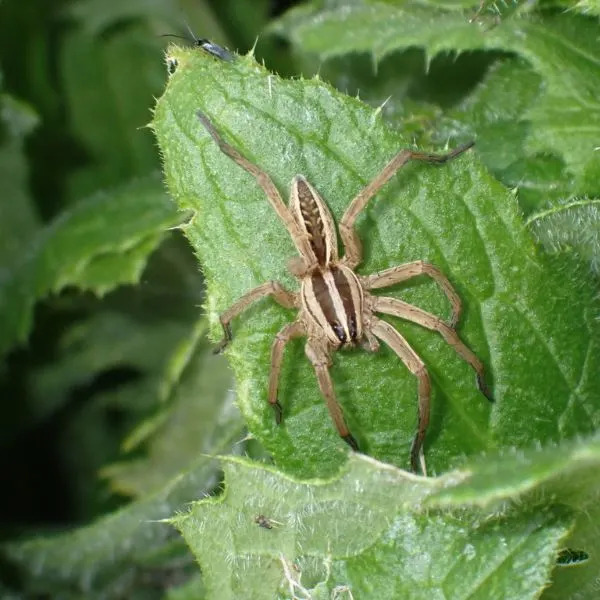
- Experience Level: Beginner
- Family: Lycosidae
- Scientific Name: Rabidosa rabida
- Other Names: Wolf Spider
- Adult Size: 0.43 to 0.83 inches
- Lifespan: Up to 2 years
- Average Price Range: N/A
There’s a good reason rabid wolf spiders are named after the wolf. Both creatures are famous for their hunting skills. Like wolves, these predatory spiders ruthlessly hunt down their prey.
However, that’s not where their similarities end. Rabid wolf spiders have excellent vision, especially at night. In general, wolf spiders probably have the keenest eyesight among all spiders in Illinois.
You can identify the rabid wolf spider by its white and brown-striped cephalothorax, the brown mid-stripe on its abdomen, and its large eyes. In particular, you’ll notice two whitish eyebrow-like markings behind its topmost pair of eyes.
On average, females tend to be larger than males. Females have a body length of around an inch, while males are about half that length. Although these species do not spin typical webs, they spin silk to make egg sacs or to wrap their prey.
Rabid wolf spiders have highly developed parenting instincts. These arachnids are known to carry their egg sacs around attached to their spinnerets until they hatch. After hatching, they carry their spiderlings on their backs until the spiderlings can care for themselves.
If you’re still wondering why they are called “rabid” wolf spiders, it’s because they are erratic and quick on their feet. Even though they appear aggressive in their posture, they are unlikely to bite unless cornered with no escape route.
The venom of a rabid wolf spider can cause allergic reactions, but it is not dangerous to humans. So you’ll be fine even if this spider bites you. But its bite is usually painful—about the same as a bee sting.
2. Northern Black Widow
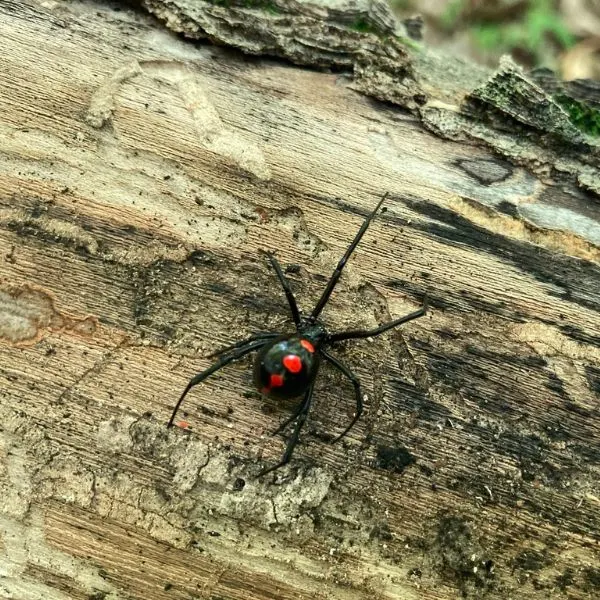
- Experience Level: Advanced
- Family: Theridiidae
- Scientific Name: Latrodectus variolus
- Other Names: Northern widow, Black widow spider
- Adult Size: Up to 0.63 inches
- Lifespan: 1 to 3 years
- Average Price Range: N/A
Although the northern black widow looks similar to the southern and western black widows, it has some peculiarities. All three black widow species have glossy black skin with a red hourglass-shaped marking on their bellies.
But, unlike the others, the red hourglass marking on the northern black widow’s abdomen is broken. Instead of a complete hourglass, the marking looks like two opposite-facing triangles.
Males have four diagonal whitish bands on each side of the abdomen. Even though they are also called black widows, male northern black widows aren’t always black. You’ll often come across male northern black widows with gray or brown bodies speckled with small red spots.
Like all black widows, female northern black widows are cannibalistic in their mating rituals. Males are smaller than females and exist solely to aid in reproduction. After mating, females ingest their male partners. The reason for this behavior is unclear.
Northern black widows rarely bite except threatened or crushed. They are shy, non-aggressive spiders, but their venom is considered up to 15 times stronger than that of a rattlesnake.
A bite from this species may cause latrodectism, which requires medical care. Besides intense pain, the venom causes breathing difficulties, weak pulse, excessive sweating, nausea, and muscle paralysis. In untreated cases, it can lead to death.
3. Bold Jumping Spider
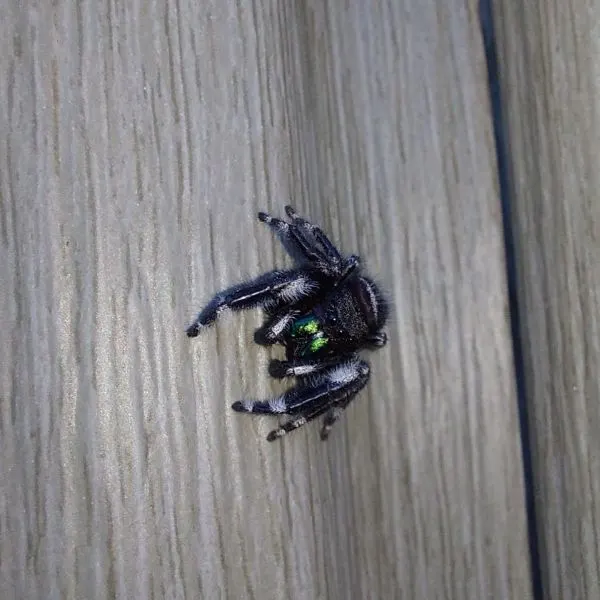
- Experience Level: Beginner to Intermediate
- Family: Salticidae
- Scientific Name: Phidippus audax
- Other Names: Bold Jumper, White-spotted Jumper, Daring Jumping Spider
- Adult Size: 0.25 to 0.75 inches
- Lifespan: 1 year
- Average Price Range: N/A
Bold jumping spiders are one of the many different spiders in Illinois. They are small, but don’t let their size fool you. Bold jumping spiders are skilled hunters that actively hunt prey instead of relying on web traps.
On good days, these arachnids can eat prey four times their size. They ambush prey and inject their victims with usually lethal doses of their venom. Sometimes, they use silk strands to prevent tough prey from escaping before consuming it.
Their ability to jump quickly and cover heights up to 50 times their body length is why they are called bold jumpers. Not many spiders in Illinois or North America can make such daring jumps.
Bold jumping spiders have short, strong back legs that help them make such high jumps. These spiders make impressive leaps by altering the blood pressure in their legs.
As is common among spiders in Illinois, female bold jumping spiders are larger than males. Females also live longer and are more frequently encountered. You can find these arachnids in forests, grasslands, and even in your home.
It’s easy to identify the bold jumping spider by the whitish spots on its black, hairy body. There are 3 spots on its abdomen. These spots fade from yellowish to white as the spider matures from juvenile to adult.
Although this arachnid is similar to other jumping spiders, like the regal jumping spider, you can differentiate it by its greenish fangs.
The bold jumper’s venom is effective at paralyzing prey, yet it is harmless to humans. It also helps that these arachnids are usually non-aggressive towards people, so bites are rare.
Although their first instinct is to run when threatened, they will sting when faced with a situation where there is no way out. The venom they inject may cause temporary pain and swelling in the bite area.
4. Cellar Spider
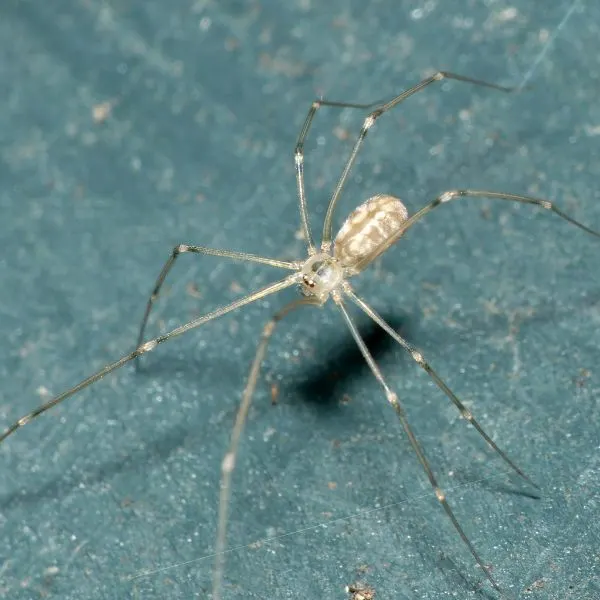
- Experience Level: Beginner
- Family: Pholcidae
- Scientific Name: Pholcus phalangioides
- Other Names: Daddy Longlegs, Granddaddy Longlegs, Daddy Longlegger, Vibrating Spider, Carpenter Spider, Long-bodied Cellar Spider, House Spider, Skull Spider
- Adult Size: Up to 0.4 inches
- Lifespan: 2 years
- Average Price Range: N/A
The cellar spider is often called daddy longlegs in many parts of the US. But these spiders weren’t originally known as daddy longlegs. The original daddy longlegs is a spider-like critter or “harvestman” from the Opiliones order.
People often mistook cellar spiders for the proper daddy longlegs, so the name stayed. The name makes sense when you observe these spiders. Even though they have tiny bodies, cellar spiders look much larger because of their very long legs.
They are one of the most common spiders in Illinois, especially in the north. They love moist places like cellars, which is why they are called cellar spiders. But they also move around and outside the house, and you can find them anywhere from attics to windowsills.
You can identify cellar spiders by their light tan or brown bodies and bulbous abdomens. Their abdomens are larger than their cephalothoraxes, but this difference is more pronounced in female cellar spiders.
Like most spiders, this species bites when held too tightly. However, its venom is harmless to humans. Most people don’t feel anything.
But if you’re allergic to spider venom, you might experience minor itching or pain where the spider bit you. Serious allergic responses are uncommon.
When frightened, cellar spiders are non-aggressive and flee from humans and predators. But they are ruthless with prey, even though they aren’t hunters. Arthropods, especially insects, are their usual victims.
Although these arachnids have weak eyesight, they are adept at detecting vibrations. As a result, they rely on their webs to catch prey. When an insect becomes entangled in one of these webs, the spider receives a vibratory signal and rushes to attack it.
5. Black Laceweaver
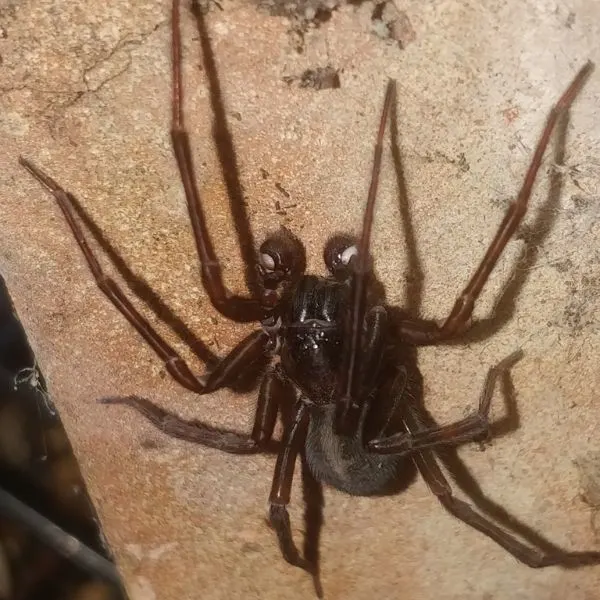
- Experience Level: Beginner
- Family: Amaurobiidae
- Scientific Name: Amaurobius ferox
- Other Names: Black lace-weavers
- Adult Size: Up to 0.63 inches
- Lifespan: Up to 2 years
- Average Price Range: N/A
This nocturnal spider is most often sighted indoors, especially around April. You’ll often find it in dark or damp locations, such as underneath logs and stones in forests or within cellars and wall crevices.
You can find adult females indoors or outdoors at any time of the year. However, you’re most likely to discover male black lace-weavers indoors in spring when they enter homes in search of female mates.
Females of this species are bigger and have less slender abdomens than males. They also live longer and play more important social roles.
As the name suggests, the black lace-weaver has a black body. However, it can also come in other shades, such as dark brown, dark red, or even tan. You can identify this species by its rounded abdomen with light yellow skull-shaped patterns.
Black lace-weavers are known for spinning cribellate webs to aid in prey capture. The web of this species is distinctive because the silk has a unique fuzzy texture generated by extremely thin and sticky threads. The spiders are named after the lace-like structure of these webs.
These spiders spin their webs at night because they are nocturnal. However, this doesn’t stop black lace-weavers from attacking any insect prey that becomes entangled in their webs during the day.
Black lace-weavers aren’t aggressive, but they do not shy away from biting people either. Their bites can cause excruciating pain, swelling, dark red bumps, and small blisters. While the intensity of these symptoms depends on whether you’re allergic or not, the venom itself isn’t medically significant.
6. Crowned Orbweaver
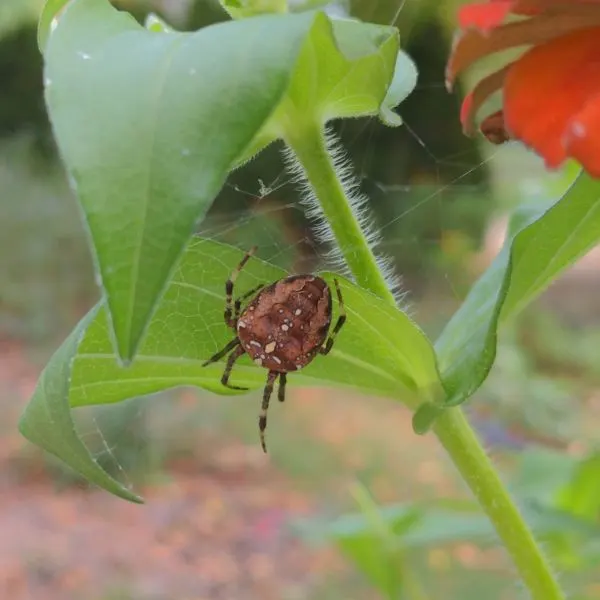
- Experience Level: Beginner
- Family: Araneidae
- Scientific Name: Araneus diadematus
- Other Names: Cross Spider, Orangie, European Garden Spider, Pumpkin Spider, Diadem Spider
- Adult Size: 0.22 to 0.79 inches
- Lifespan: 1 year
- Average Price Range: N/A
Crowned orb-weavers are famous for the cross mark on their bodies. Individual spiders can vary in color from pale yellow to dark grey, but all crowned orb-weavers have mottled white markings on the dorsal abdomen, with four or more segments creating a cross.
Like other orb-weaving spiders, their legs are specialized for spinning orb webs. These arachnids are skilled predators that use their webs to capture prey. After their webs catch prey, these spiders immobilize their victims and wrap them in silk for later consumption.
In addition to catching and successfully eating prey, crowned orb-weavers are cannibals that eat one another. This, however, only often occurs before, during, or after sexual activity.
They don’t extend this aggressive behavior towards humans and larger animals. These arachnids are reclusive and avoid human interaction. However, if cornered or otherwise provoked, these solitary critters will bite you.
One thing you may find interesting is that when these orb-weavers are disturbed, they vibrate their webs fast until they become blurry, confusing potential predators.
Like other spiders in Illinois, the female crowned orb-weaver is bigger than the male. Males also scarcely survive mating because females consume them soon after.
7. Black and Yellow Garden Spider
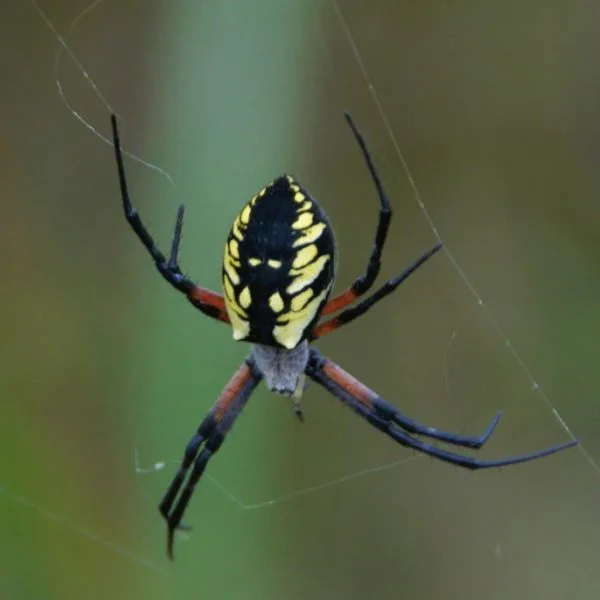
- Experience Level: Beginner
- Family: Araneidae
- Scientific Name:
- Other Names: Zipper Spider, Black And Yellow Argiope, Zigzag Spider, Yellow Garden Spider, Writing Spider, Golden Garden Spider, Mckinley Spider, Corn Spider, Steeler Spider
- Adult Size: 0.20 to 1.10 inches
- Lifespan: 1 year
- Average Price Range: N/A
Black and yellow garden spiders are widespread in Illinois. These creatures are partial to gardens, meadows, fields, and parks. But you’ll find them anywhere they can find structures to anchor their webs.
Although individual spiders may vary in appearance, these arachnids share a common feature: unmistakable black and yellow markings on their abdomens. The carapace of the yellow garden spider is coated with silvery hairs, and the legs are black with red, orange, or even yellow bands.
This species has different names due to specific features. For example, it’s sometimes called the writing spider because of the huge web decorations it weaves with silk. It’s also called the zigzag spider because mature female black and yellow garden spiders usually weave a zigzag pattern in the center of their webs.
The black and yellow garden spider is not selective with its meals. It will eat anything that lands on its web. However, this species is not as skilled as hunter spiders.
Yellow garden spiders are quite vulnerable to predators due to their poor eyesight. As a result, they rely on their ability to sense vibrations and changes in air currents to detect predators.
Most times, when this garden spider detects a potential predator, it vigorously shakes its web to appear larger. But in cases where that doesn’t deter the visitor, the spider usually drops from its web and hides.
Yellow garden spiders are a pleasant sight to behold. They also rarely bite, except when threatened. Luckily, their venom is harmless to humans. But their bites can hurt, especially if you’re allergic to spider venom.
If you find these spiders in your garden, don’t be in a hurry to get rid of them. They are quite helpful in managing pests.
8. Woodlouse Hunter
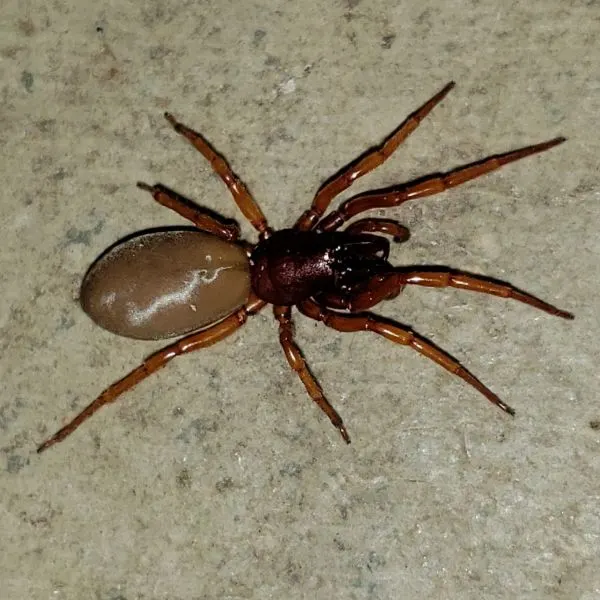
- Experience Level: Beginner to Intermediate
- Family: Dysderidae
- Scientific Name: Dysdera crocata
- Other Names: Slater Spider, Sowbug Killer, Roly-Poly Hunter, Long-Fanged Ground Spider, Cell Spider, Sowbug Hunter, Orange Spider, Woodlouse Spider, Pillbug Hunter, Dysderid Spider
- Adult Size: 0.35 to 0.59 inches
- Lifespan: 3 to 4 years
- Average Price Range: N/A
Woodlouse hunters are called so because woodlice are their favorite prey. These spiders often look for woodlice under logs, rocks, bricks, plant pots, and leaf litter.
Unlike many other spiders in Illinois, woodlouse hunters do not spin webs to catch prey. Instead, they aggressively pursue victims and sting them into surrender.
The spiders quickly begin feeding after paralyzing their prey. They are nocturnal, so hunting is usually done at night.
You’re most likely to come across woodlouse spiders in April and May. These hunters favor damp and warm habitats outdoors. However, these arachnids enter homes as well and hide in wall crevices when temperatures start to drop.
The blood-red or brownish-orange cephalothorax and yellowish-brown abdomen distinguish this species from other spiders in Illinois. Its legs are reddish-brown, particularly at the extremities.
Some people confuse woodlouse spiders with brown recluses. But you can easily tell the difference by examining their backs. Woodlouse spiders lack the violin-shaped marking characteristic of recluses.
Although this spider’s bite can cause you pain, there’s no need to panic if it bites you.
The woodlouse hunter’s venom is not a health hazard to humans. The symptoms fade on their own after a while, but they may last longer in allergic people.
9. Brown Recluse
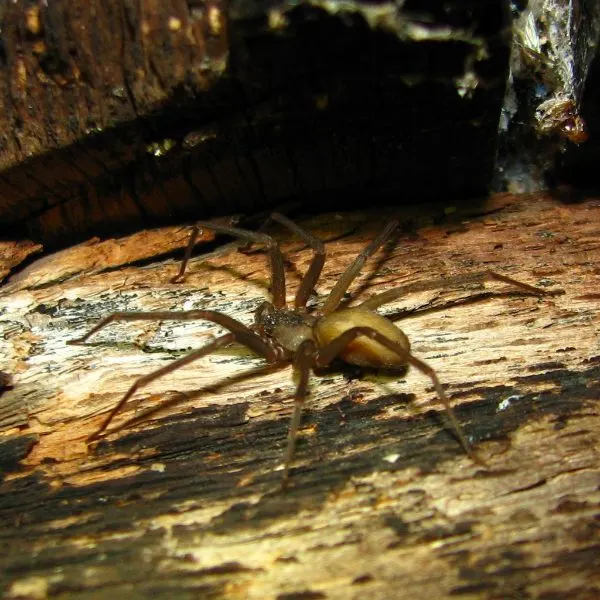
- Experience Level: Advanced
- Family: Sicariidae
- Scientific Name: Loxosceles reclusa
- Other Names: Brown Fiddler, Fiddleback, Violin Spider
- Adult Size: 0.24 to 0.8 inches
- Lifespan: 2 to 4 years
- Average Price Range: N/A
The brown recluse is one of the most dangerous spiders in Illinois. This infamous spider inflicts severe bites that typically require medical attention.
Its venom is cytotoxic, meaning it kills cells in the area of the bite. This can lead to big ulcers that deepen and become more difficult to treat. If you don’t treat it on time, you might end up with a large scar after the wound heals.
Although its reputation precedes it as a dangerous species, this spider is not aggressive. When threatened, brown recluses will either flee or curl into themselves and pretend to be dead.
Bites usually happen when you accidentally brush up against this arachnid, causing it to sting you in self-defense. Most times, brown recluses only use their venom to paralyze prey before eating. Its typical diet includes flies, mosquitoes, and crickets.
You can identify this arachnid by its most defining feature: a violin-shaped pattern on its carapace. The violin marking on the brown recluse spider varies in intensity depending on its age, with mature spiders possessing dark violin forms.
The brown recluse is usually tan to dark brown. It also has 6 eyes instead of the 8 seen in most spiders in Illinois.
Some brown recluses have reddish-brown fangs and hairy mouthparts. The legs are hairy as well but lack lengthy spines.
10. Tan Jumping Spider
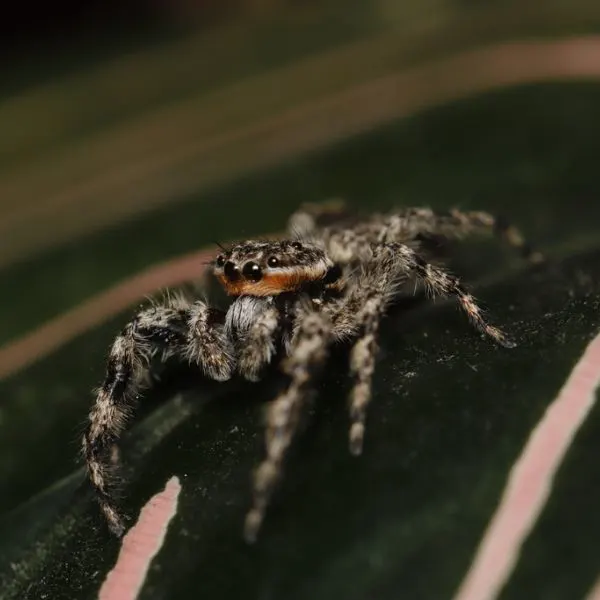
- Experience Level: Beginner
- Family: Salticidae
- Scientific Name: Platycryptus undatus
- Other Names: Jumping Spider
- Adult Size: 0.33 to 0.51 inches
- Lifespan: 1 year
- Average Price Range: N/A
Tan jumping spiders are true natives of Illinois. You’ll usually find these arachnids on fences, tree barks, and wooden or vertical surfaces. Although you may also find these spiders indoors, these arachnids spend more time outdoors.
Like most spiders, these jumping arachnids have 8 eyes. However, all their eyes are forward-facing, which is unusual.
The precise color scheme of this species varies from spider to spider. You’ll often come across gray, black, tan, and brown individuals with flecks of white, brown, and sometimes reddish patches that help them blend into their surroundings.
Some tan jumping spiders are colored like zebras, while others appear to be uniformly gray. Tan jumping spiders also have chevrons that are lighter in color than the rest of their flattened bodies.
The fangs of male tan jumping spiders are fuzzy and usually white. In contrast, females usually have black glossy and hairless fangs. Females are also larger than males.
The courtship dances of jumping spiders are fascinating. Male tan jumping spiders drum on the ground in rhythmic patterns using their forelegs, which they wave around to invite females.
Tan jumping spiders are solitary creatures that are active during the day. They don’t build conventional web traps. Instead, they prefer to ambush prey and inject their victims with venom before eating them.
11. Striped Fishing Spider

- Experience Level: Beginner
- Family: Pisauridae
- Scientific Name: Dolomedes scriptus
- Other Names: Raft Spider, Wharf Spider, Dock Spider, Fishing Spider
- Adult Size: Up to 1 inch
- Lifespan: 1 year
- Average Price Range: N/A
Striped fishing spiders are large-sized spiders native to most parts of the United States, including Illinois.
You can also find them in parts of Canada. Like most fishing spiders, they inhabit coastal forests and often hang around river banks searching for prey.
These spiders are typically pale brown, with light stripes running down both sides of their bodies. They also have light stripes on their legs. The large size of these spiders is mostly due to their long legs.
Like many spiders in Illinois, there are specific features you can use to differentiate male and female striped fishing spiders.
For example, females are usually lengthier in leg span. They also have a dark band around their cephalothorax, while males have white bands and are slightly smaller.
Like other fishing spiders, striped fishing spiders do not spin web traps. Instead, they have other means of catching prey.
These arachnids detect prey movement by sensing vibrations on the water surface. They then skate across the water to capture and subdue it.
These fascinating creatures can also dive underwater to catch small fish and other aquatic animals.
12. Marbled Orbweaver
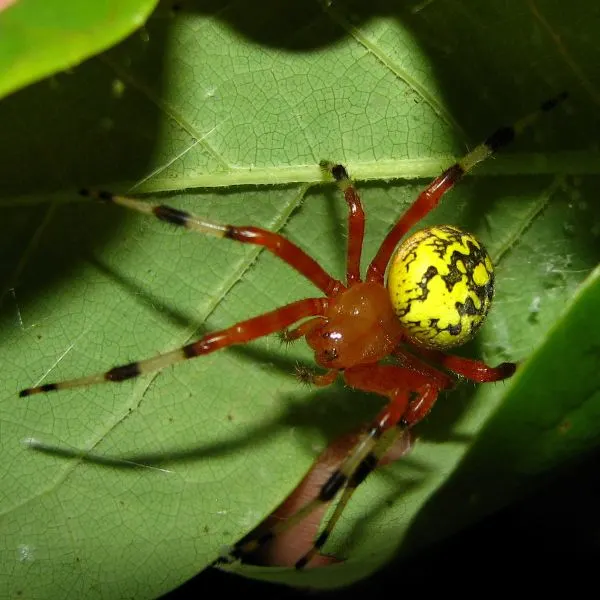
- Experience Level: Beginner
- Family: Araneidae
- Scientific Name: Araneus marmoreus
- Other Names: Pumpkin Spider
- Adult Size: 0.2 to 0.7 inches
- Lifespan: Six months
- Average Price Range: N/A
Marbled orb-weavers are known for their large, oval abdomens and lovely patterns. Their abdomens have marble-like patterns, which may be orange, white, black, or yellow. Their legs also have black and white stripes.
You’ll usually find this beautiful spider in shrublands, forests, meadows, fields, and suburban areas. Marbled orb-weavers are solitary beings that are usually active at night.
Like other spiders in Illinois, female marbled orb-weavers are bigger than their male counterparts. Most marbled orb-weavers you’ll encounter are females, while male sightings are more common in mating seasons.
Marbled orb-weavers prey on several types of small insects. To catch prey, they weave webs and attach a signal thread to the side of the web.
When their prey becomes stuck in the webs, the signal thread vibrates, alerting them. They then emerge from their hiding place and attack the prey. This strategy also helps them evade predators.
Despite what you might think, these spiders are not aggressive. They usually don’t bite people. In addition, their venom is not harmful to humans. It’s only useful for subduing prey and fending off predators.
13. White-banded Crab Spider
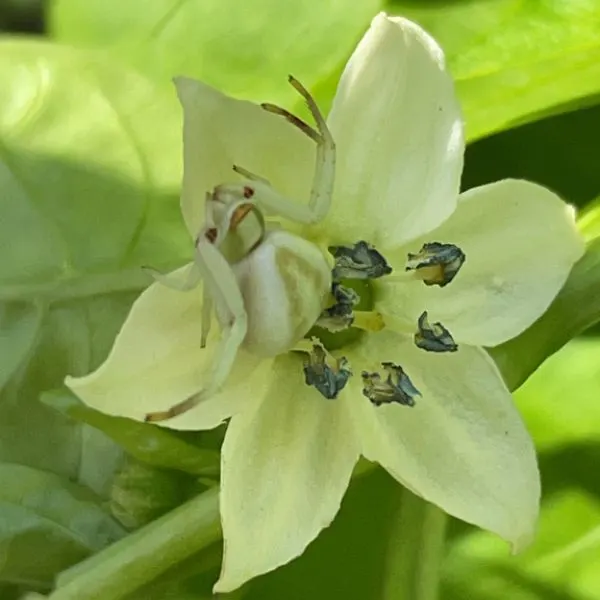
- Experience Level: Beginner
- Family: Thomisidae
- Scientific Name: Misumenoides formosipes
- Other Names: Crab Spider, Yellow Crab Spider, Ridge-faced Flower Spider, White Crab Spider, Red-banded spider
- Adult Size: 0.31 to 0.55 inches
- Lifespan: 1 year
- Average Price Range: N/A
White-banded crab spiders are one of the few spiders in Illinois with the ability to change their colors. These spiders can switch from white to yellow or vice versa, depending on the flower they are on.
However, their colors do not change instantly. It can take about three to nine days for this to happen.
Pollinators like bees, moths, and butterflies make up the bulk of their diet. But these arachnids also eat other spiders. Besides arthropods, pollen is a common source of energy for males in search of female mates.
The color and pattern of this species vary with location. The base color of a female’s body is typically yellow, white, or light brown.
The abdomen can have brown, blank, or red markings. It is also widest at the rear end, forming a rounded triangle shape when viewed from above.
Adult male white-banded crab spiders are significantly smaller than females, and they come in a variety of colors, including green, gleaming red, and/or yellow. Their front legs are dark, while their back legs are bright yellow or green.
The species get its name from the white band running through the middle of its carapace.
14. Rustic Wolf Spider
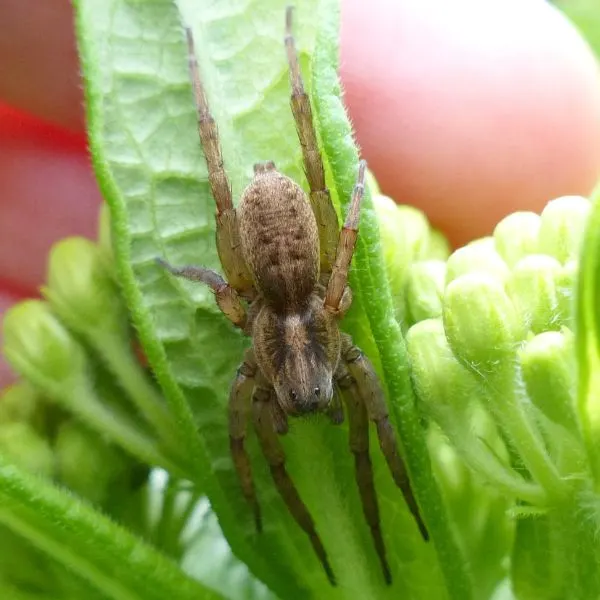
- Experience Level: Beginner
- Family: Lycosidae
- Scientific Name: Trochosa ruricola
- Other Names: Wolf Spider
- Adult Size: Up to 1 inch
- Lifespan: 1 year
- Average Price Range: N/A
Illinois is home to at least 47 species of wolf spiders, and the rustic wolf spider is one of them.
You will often find this spider in woodland scrubs, lawns, and grasslands. They hunt on the ground and usually go after insects and other small arthropods.
As is common among wolf spiders, female rustic wolf spiders show strong maternal care. They carry their egg sacs around on their spinnerets for about three weeks until spiderlings emerge. These baby spiders congregate on the mother’s back for a while before moving on.
Rustic wolf spiders have dark brown carapaces and a whitish stripe running down the length of this carapace. The stripe continues up to the first part of the abdomen.
Sadly, it’s easy to mix them up with other wolf spider species because they don’t have very distinctive features.
Most people group wolf spiders together because species confirmation often requires expert help. Usually, you’ll need to examine body parts like their genitalia under high magnification and good lighting to be sure.
15. Arrowhead Spider
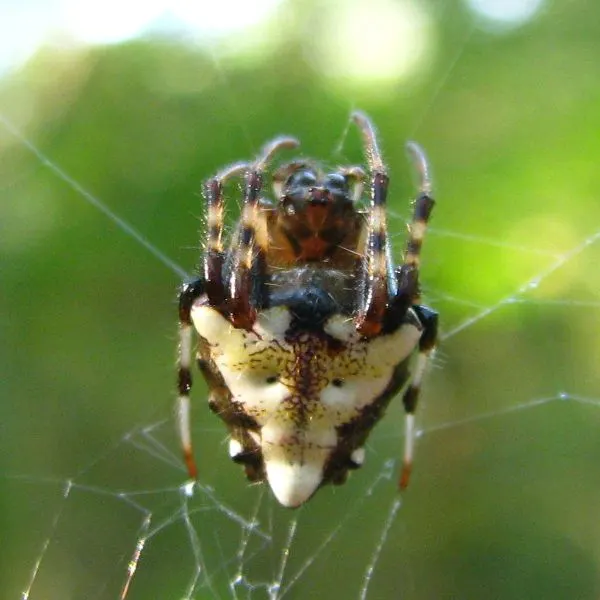
- Experience Level: Beginner
- Family: Araneidae
- Scientific Name: Verrucosa arenata
- Other Names: Arrowhead Orb-weaver, Triangulate Orb-weaver
- Adult Size: 0.15 to 0.55 inches
- Lifespan: Up to 1 year
- Average Price Range: N/A
Arrowhead spiders are one of the few huge orb-weaving spiders that sit in their webs facing upwards instead of upside-down. They have a sharp, triangular abdomen that resembles the tip of an arrow, which is what they are named after.
Besides having triangular abdomens, they have a triangular patch covering their abdomens. This arrowhead-shaped patch is usually yellow or whitish. However, this shape is usually absent or indistinct in males.
Females usually have black, brown, or rusty red legs. They are relatively larger than males and are the more socially relevant sex. Unless they are mating or courting a female spider in their web, you’ll rarely see male arrowhead spiders in webs.
These spiders’ diet is mostly made up of small flying insects. They capture these insects by entangling them in their sticky webs.
They then use venom to subdue their victims and liquefy their insides. They wait for a while before returning to their victim to consume its liquid contents.
Arrowhead spiders also have stronger webs than most of the other orb-weavers in Illinois. The webs they spin are practically invisible to their prey, which is why they successfully trap many. The webs consist of a central hub with no radial threads.
You can find arrowhead spiders in woodlands, yards, plantations, gardens, and urban parks. You’ll generally come across these critters in open, humid areas, where they can get direct sunshine. As a result, most sightings occur in late summer and early fall.
16. American Grass Spider
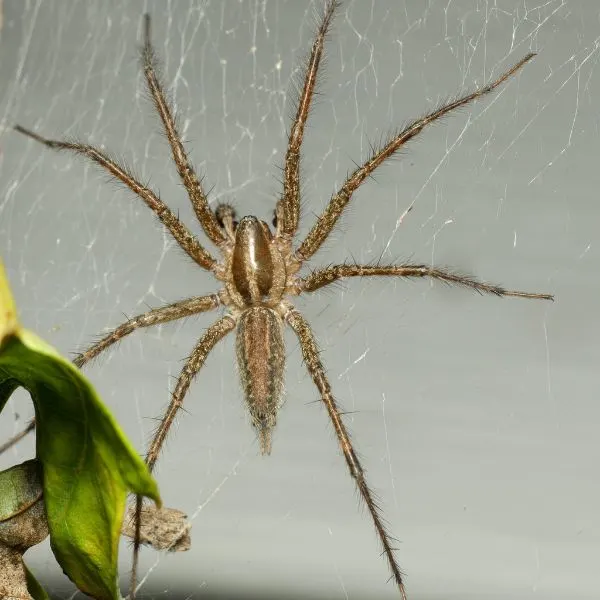
- Experience Level: Beginner
- Family: Agelenidae
- Scientific Name: Agelenopsis spp.
- Other Names: Sheet Web Spiders, Funnel Weavers, Grass Spiders, Funnel Web Spiders, Ground Spiders
- Adult Size: 0.4 to 0.8 inches
- Lifespan: 1 year
- Average Price Range: N/A
As their name suggests, you’ll usually see American grass spiders in rich grasslands or forests. They have brownish bodies, and their abdomens have two distinct jagged light stripes bordered by black to dark brown lines. Their abdomens also end in two pikes.
The cephalothorax of American grass spiders also has alternating light and dark stripes running down it. In some American grass spiders, the cephalothorax is wider than the abdomen, but this isn’t always the case.
These spiders also share an uncanny resemblance with hobo spiders and wolf spiders, so people often mistake them for each other. But you can tell the difference if you closely examine their carapaces. American grass spiders have a distinct chevron marking pointing anteriorly.
Although there are multiple species of American grass spiders in Illinois, it’s difficult to tell the different species apart without expert help.
These arachnids are called sheet-weavers or funnel-weavers because they spin sheet-like horizontal webs with an upside-down funnel-shaped web underneath. They usually construct the funnel part of their nests just above their shelter.
Their diet comprises mainly arthropods, which they trap using webs. These spiders hide in the funnel-shaped section of their webs, waiting for prey to fall onto the sheet. After detecting vibrations caused by struggling prey, these spiders swoop in to sting their victims.
American grass spiders are safe to be around. They don’t usually attack people and only bite in self-defense. You’ll probably feel pain if this spider bites you, but the venom is harmless.
17. Shamrock Orb-Weaver
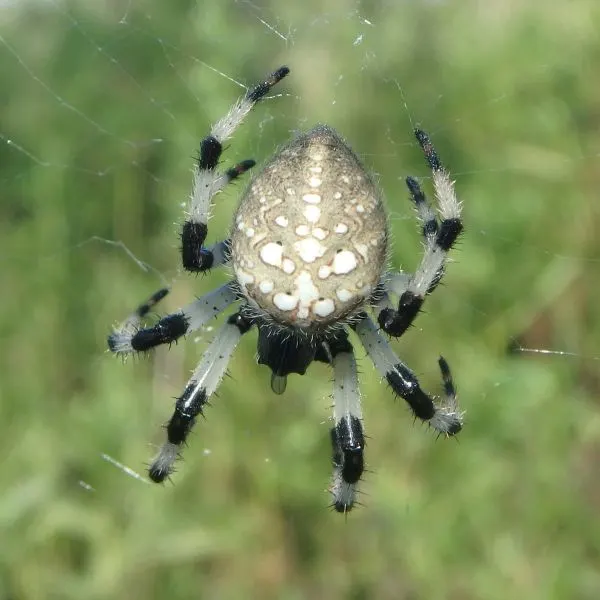
- Experience Level: Beginner
- Family: Araneidae
- Scientific Name: Araneus trifolium
- Other Names: Shamrock Spider, Pumpkin Spider
- Adult Size: Up to 0.9 inches
- Lifespan: 1 year
- Average Price Range: N/A
Shamrock spiders are usually beige or brown. But many have large, round abdomens with yellow, green, brown, or orange markings. Individuals with orange abdomens often get mistaken for marbled orb-weavers.
The cephalothorax of most shamrock spiders is dark brown, and their legs usually have alternating white and brown rings.
These hairy arachnids favor humid habitats and generally sit in the center of their webs. However, these spiders often retreat to conceal themselves from prey or potential predators.
After retreating, they remain attached to the web by a single strand. This connection helps them detect vibrations caused by potential prey.
The webs shamrock spiders build may be as wide as 2 feet. After consuming the prey they’ve caught, these spiders often dismantle the webs in the morning. They spend most evenings rebuilding these webs only to repeat the same cycle.
Shamrock spiders can inflict painful bites, but their venom is harmless to humans. The spiders aren’t aggressive, so you’ll usually only get bitten if you disturb them.
18. Banded Garden Spider
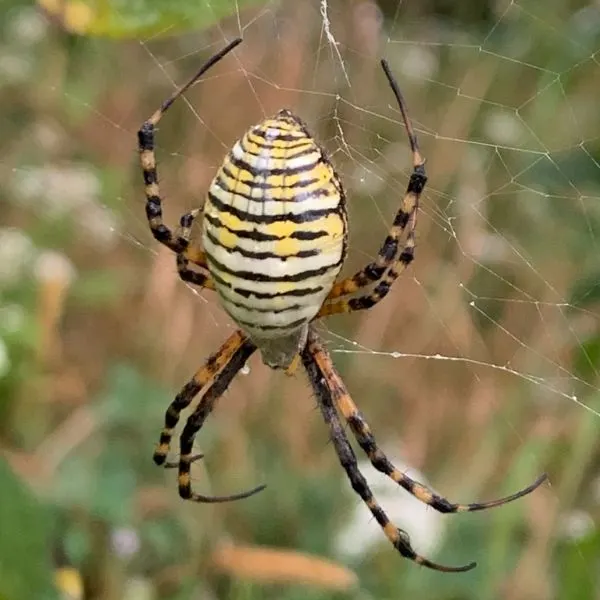
- Experience Level: Beginner
- Family: Araneidae
- Scientific Name: Argiope trifasciata
- Other Names: Orb-weaver Spider, Yellow Garden Spider
- Adult Size: 0.59 to 0.98 inches
- Lifespan: 1 year
- Average Price Range: N/A
Banded garden spiders are known for their bright yellow bodies and long, spindly legs. As their name hints, these spiders often live in gardens, prairies, forests, and other habitats rich in green vegetation.
They have an oval-shaped abdomen and are distinctively large-bodied. But as is commonplace with most spiders, the males are substantially smaller than the females.
They are remarkably similar to the yellow garden spider, although the latter is slightly larger and more stunningly colored. A distinctive characteristic of the banded garden spider is the faint U-shaped marking on the top of its abdomen.
These arachnids are not hunters. They spin intricate webs and simply wait for prey to walk into these webs. Once they catch their prey, they wrap it in silk and inject venom into its body to consume later. You’ll usually find them resting during the day in the center of their web.
Although you’ll often find banded garden spiders and yellow garden spiders living in close quarters, these arachnids aren’t very social. Garden spiders generally live solitary lives and are aggressive towards other spiders, except during mating seasons.
Banded garden spiders pose no threat to humans. They rarely bite. But even when they do, the bites have the same effect as the sting of a wasp and will only cause minimal swelling and mild pain.
19. Long-legged Sac Spider
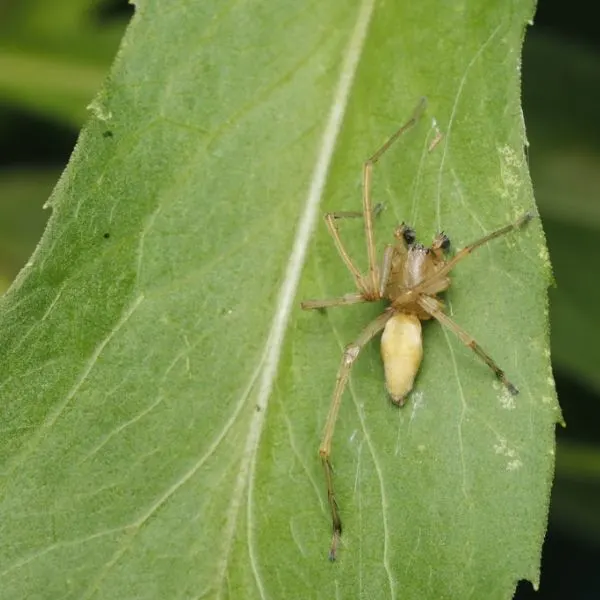
- Experience Level: Beginner to Intermediate
- Family: Cheiracanthium
- Scientific Name: Cheiracanthium mildei
- Other Names: Black-footed Spider, Yellow Sac Spider, Yellow House Spider
- Adult Size: 0.3 to 0.4 inches
- Lifespan: 1 year
- Average Price Range: N/A
The long-legged sac spider is so-called because of its relatively long legs. While all its legs are long, the front pair is often noticeably longer than the others.
This species typically makes its home on ceilings in houses and offices. You’ll also often find its thin, silk tent-like shelter in wall corners, in furniture crevices, or in dimly lit spaces.
Its tent-like nest is not built to hunt prey but for resting. They do not build web traps.
The long-legged sac spider typically has a greenish-yellow or yellowish-tan body. The body is covered in short hairs and is large without any marking, save for the dark stripe in the middle of the abdomen. The mouthparts in most variants are dark brown.
You’ll also notice that the legs of the long-legged spider are darker than the rest of the body, usually dark brown or solid black. This species is a fast runner and ambush predator, preferring to hunt prey under cover of darkness.
Long-legged spiders don’t attack people unprovoked. However, most people consider them pests at home because they inflict very painful bites when threatened or crushed.
Although the venom of this arachnid is not considered medically significant, the symptoms can last anything from a few hours to a few days. Allergic people may also experience mild fever and swelling.
20. Bridge Orbweaver
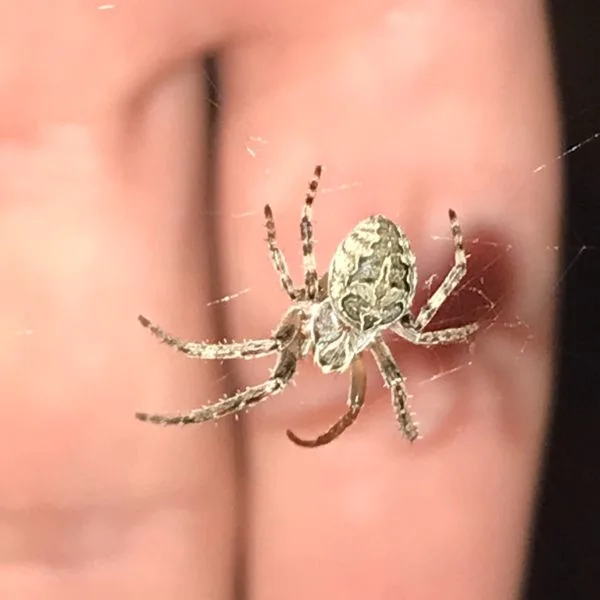
- Experience Level: Beginner
- Family: Araneidae
- Scientific Name: Larinioides sericatus
- Other Names: Gray Cross Spider
- Adult Size: 0.31 to 0.55 inches
- Lifespan: 1 year
- Average Price Range: N/A
Bridge orb-weavers are attracted to light sources, especially artificial ones. As a result, you’ll often find them in cities or other urban areas.
These spiders favor metallic man-made structures, such as well-lit bridges. Their affinity for bridges is likely due to the light reflected from the water underneath.
On good days, you might find up to 100 of these spiders per square meter in some well-lit metropolitan areas. Their congregation around light sources is likely because light sources attract tons of insects, their favorite type of prey.
These spiders aren’t hunters, so they don’t actively pursue these insects. Instead, these nocturnal orb-weavers build large webs in insect hotspots and wait patiently in the middle for victims to get stuck.
Unlike other orb-weavers, which spin elliptical webs, this species weaves circular webs that grow in size over time. Sometimes these spiders build their webs close to each other, but they aren’t social. Bridge orb-weavers are highly territorial and are aggressive towards members of their species.
Male bridge orb-weavers are slightly larger than females, although they weigh considerably less. However, in rare cases, females will eat male bridge orb-weavers when food is low.
This species’ venom isn’t poisonous enough to harm humans. But since its fangs can easily penetrate human skin, you’ll experience some skin irritation or pain. If you’re allergic to spider venom, these symptoms might be more pronounced.
You can identify bridge orb-weavers by the gray cross-shaped marking on their abdomens. This marking is why they are also called gray cross spiders. The body is covered in tiny whitish hairs, and the legs have alternating light and dark rings.
21. Common House Spider
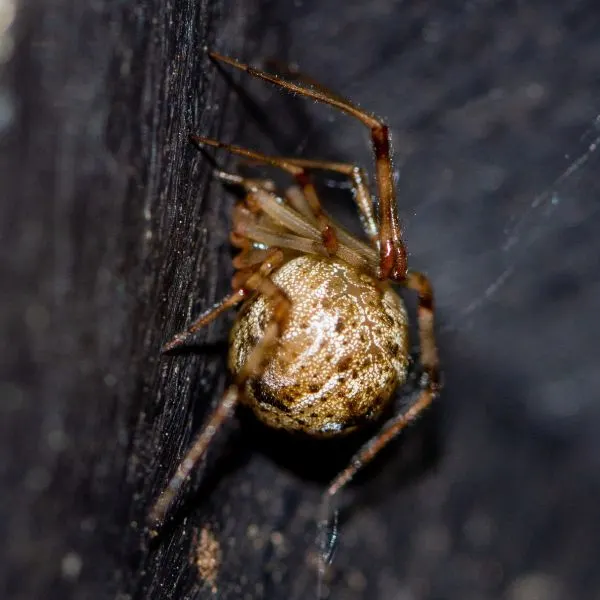
- Experience Level: Beginner
- Family: Theridiidae
- Scientific Name: Parasteatoda tepidariorum
- Other Names: House Spider, American House Spider
- Adult Size: 0.125 to 0.75 inches
- Lifespan: 1 to 7 years
- Average Price Range: N/A
The common house spider is one of the most widespread spiders in Illinois. You’ll find it in cellars, wall fissures, windowsills, and attics in most homes.
Although these spiders love living in inhabited buildings, they usually avoid human interaction.
Common house spiders have slender and dark banded legs. Like most cobweb spiders, the abdomen of this species is larger than its body. This abdomen is usually brown with dark markings.
You’ll usually find many common house spiders inhabiting the same space. They make webs with such small spacing that the distinctions between individual webs blur. Like most cobweb spiders, the webs this species build are tangled and disorganized.
Common house spiders are not hunting spiders, so they depend on their webs to catch prey. They detect vibrations when their webs have caught prey and race to the site to sting their victims.
The venom of this spider is a neurotoxin similar to those of black widows, but it is much weaker. Common house spiders are unaggressive, so they rarely bite. But when they do, you may experience localized pain and moderate swelling that doesn’t need treatment.
Bites from female common house spiders are more likely to cause reactions than bites from males. If you’re allergic to spider venom, your symptoms may be slightly more intense, and you’ll likely also experience itching.
22. Dotted Wolf Spider
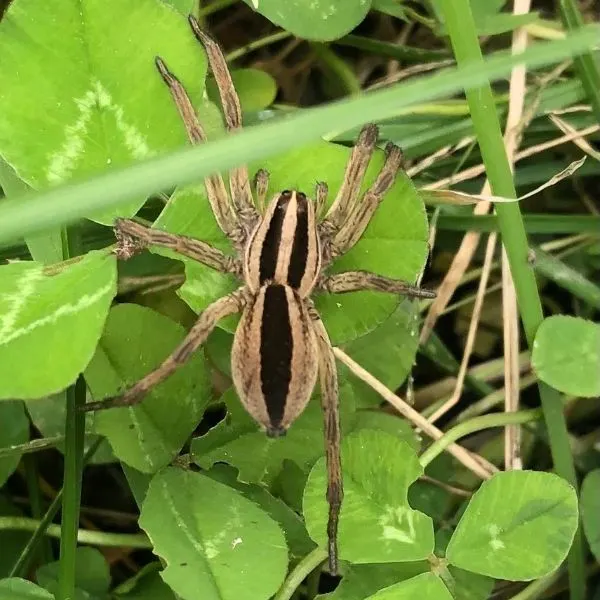
- Experience Level: Beginner
- Family: Lycosidae
- Scientific Name: Rabidosa punctulata
- Other Names: Wolf Spider
- Adult Size: 0.43 to 0.67 inches
- Lifespan: 1 year
- Average Price Range: N/A
Like all wolf spiders, dotted wolf spiders are skilled hunters. They do not spin webs to catch their arthropod prey. Instead, they track prey down and inject their victims with lethal doses of their venom.
Although these spiders look like rabid wolf spiders, you can identify them by the pattern of black spots on the yellowish-tan underside of their abdomens. They also have solid brown stripes running down the midline of their abdomens. These stripes are clearer when viewed aerially.
Female dotted wolf spiders have strong parental instincts. They hold their egg cases in their spinnerets until the eggs hatch. Young dotted wolf spiders also ride around on their mother’s abdomen until they are strong enough to depend on themselves.
Dotted wolf spiders don’t typically attack people, but females can be fiercely protective of their eggs and spiderlings. Mothers forced to drop their egg sacs when threatened by predators often return to the scene later to gather the eggs.
If these spiders feel threatened but can’t escape, they resort to biting. Fortunately, the venom of these arachnids isn’t toxic to human beings. If you’re allergic, you might experience mild swelling and pain, but these symptoms should clear on their own.
23. Eastern Parson Spider
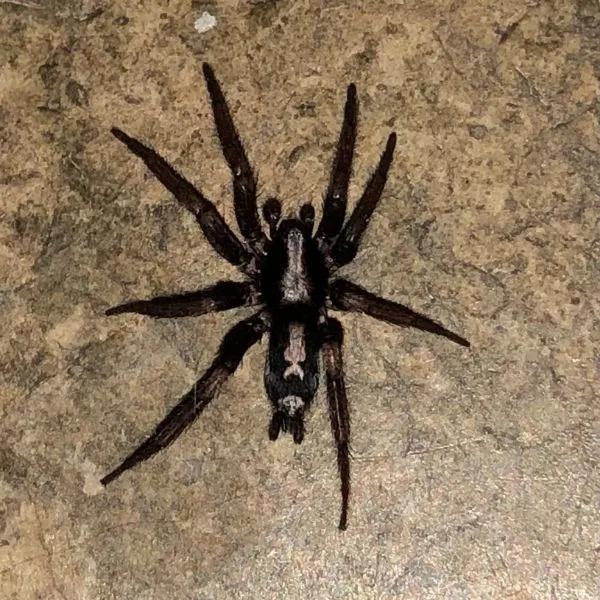
- Experience Level: Beginner
- Family: Gnaphosidae
- Scientific Name: Herpyllus ecclesiasticus
- Other Names: Stealthy Ground Spider, Ground Spider
- Adult Size: 0.2 to 0.51 inches
- Lifespan: 1 to 2 years
- Average Price Range: N/A
Eastern parson spiders can be found in many houses and underneath rocks or fallen leaves in Illinois. They are usually black, but you might come across individuals coated in two colors: black hair on the cephalothorax and gray hair on the belly.
You can identify them by their velvety appearance and a distinguishing white or pink mark in the middle of their abdomens. These abdominal markings resemble the neckband worn by clergy (parsons) in the 18th century, after which they are named.
The eastern parson spider has incredible speed, especially when hunting prey at night. One of its distinguishing qualities is that it sprints in a zigzag pattern, making it difficult for predators to catch it.
Like many other spiders in Illinois, female eastern parson spiders are slightly larger than males. Females also have longer lifespans compared to males.
Eastern parson spiders are social animals, so they often move in groups. Their reproductive rate is also impressive. These arachnids mate almost throughout the year, laying as many as 3,000 eggs.
Unless provoked, eastern parson spiders aren’t aggressive towards people. Their bites can be quite painful and trigger allergic reactions, but the venom is not medically significant.
24. Dark Fishing Spider
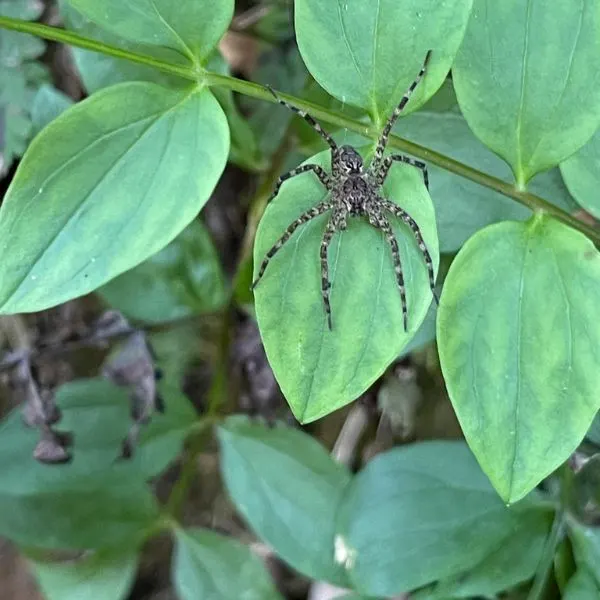
- Experience Level: Beginner
- Family: Pisauridae
- Scientific Name: Dolomedes tenebrosus
- Other Names: Wharf Spider, Dock Spider, Nursery web Spider, Raft Spider
- Adult Size: 0.27 to 1.02 inches
- Lifespan: 1 to 2 years
- Average Price Range: N/A
You can find dark fishing spiders under or around rocks, shrubs, and other vegetation in coastal areas. You may also encounter these arachnids around buildings, hiding under logs or garden stumps. During cold seasons, these spiders may move into homes in search of warmth.
These spiders are nocturnal hunters with good vision, with which they stalk their victims before attacking. They don’t spin webs to trap prey. But they sometimes rely on vibrations on water surfaces to detect prey.
Like other fishing spiders, dark fishing spiders can walk on water surfaces. They hunt insects and other arthropods they find hanging on the surface film. These generalist feeders sometimes feed on prey almost five times their size.
They can submerge their bodies just under the surface of calm water and hunt for small fish and tadpoles. These arachnids can stay underwater for more than thirty minutes at a time when hunting.
Dark fishing spiders are typically dark brown with black and light brown markings. It’s easy to mistake them for wolf spiders. But, unlike wolf spiders, their abdomens have dark W-shaped patterns on the dorsal surface.
Like nearly all spiders in Illinois, dark fishing spiders are venomous. While bites can be painful, the venom is not medically significant. But bites are rare, so don’t worry. Most reported bites will happen when people brush their bodies against the spiders and frighten them.
25. Bowl and Doily Spider
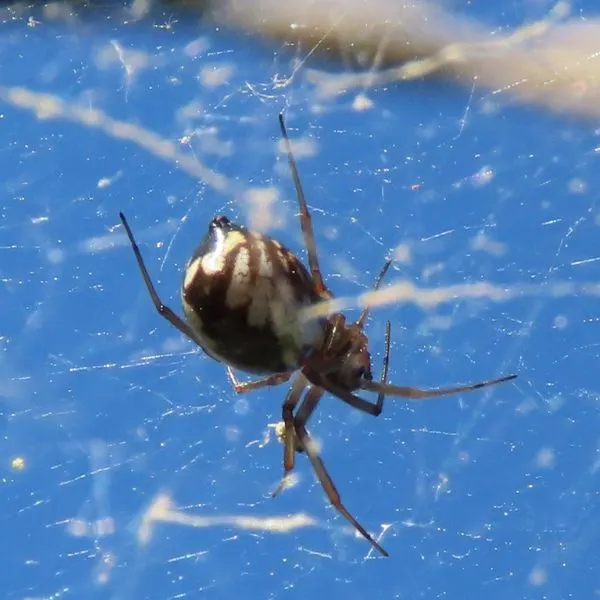
- Experience Level: Beginner
- Family: Linyphiidae
- Scientific Name: Frontinella pyramitela
- Other Names: Sheet-weavers
- Adult Size: Up to 0.15 inches
- Lifespan: 1 year
- Average Price Range: N/A
Bowl and doily spiders are tiny, so they are easy to miss. But these interesting arachnids are present all over Illinois.
They favor damp environments with plenty of vegetation. Sightings are most common in summer when males and females often share a web.
These spiders earned their name from the type of webs they spin. They spin inverted dome or bowl-shaped webs with a doily-like horizontal sheet underneath. Although these webs aren’t sticky, they are effective at attracting prey.
Bowl and doily spiders feed on insects and other arthropods that become entangled in their webs. They normally wait on the bottom sheet for an insect to enter the bowl-shaped web. When an insect enters, these spiders quickly inject it from outside the bowl before rushing in to finish it off.
These spiders’ webs can be several inches wide and are typically built by adult females. Males are only allowed to share these webs with females.
This species possesses a huge, spherical abdomen that’s several times the size of its cephalothorax. The abdomen and cephalothorax are lustrous and dark brown to black, and you’ll observe multiple white comma-like marks on the side of its abdomen.
The inverted comma-like patterns on the sides of the abdomen curve under the spider. These patterns normally get more yellowish as they get closer to the underside. The legs are pale brown and sparsely bristled.
Bowl and doily spiders run when threatened, so they rarely bite people. Their venom is medically insignificant, but their bites might hurt, especially if you’re allergic to spider venom.
26. Filmy Dome Spider
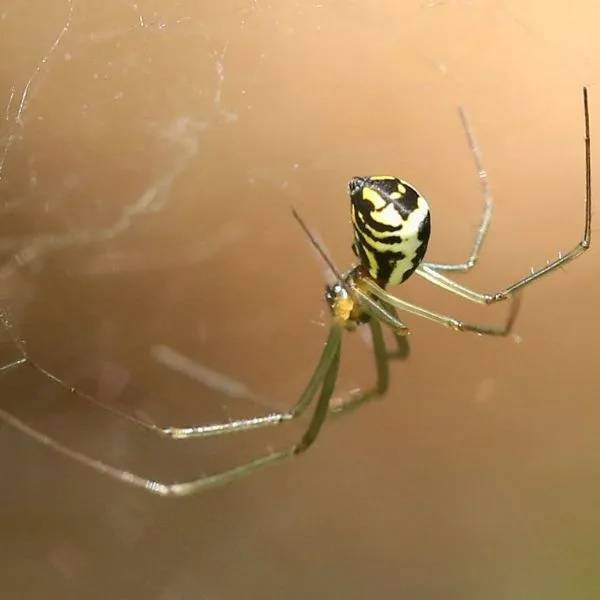
- Experience Level: Beginner
- Family: Linyphiidae
- Scientific Name: Neriene radiata
- Other Names: Sheet-Weavers
- Adult Size: Up to 0.25 inches
- Lifespan: 1 year
- Average Price Range: N/A
You can find filmy dome spiders in Illinois and most parts of the US. They prefer forest edges and areas with low vegetation. You may also encounter these spiders at home, but they often stay confined to wall corners and damp, dimly-lit places.
They are small spiders with brown or black bodies. They also have a pair of straight yellow or white lines on their abdomen. Some variants may have two-colored bodies with a brown head and a white-black abdomen.
These spiders construct their silk webs in open regions where they can readily trap prey. Small insects like gnats, ants, wasps, and mosquitoes make up the bulk of their diet.
Filmy dome spiders are solitary creatures that live alone and only come together during mating seasons. Male spiders vibrate to attract females during mating seasons. Sadly, males typically die shortly after the courting stage ends, while females lay their eggs in their webs.
Female dome spiders look after their eggs, incubating them after mating seasons. These spiders usually die when winter arrives, so many don’t live to see their eggs hatch.
Filmy dome spiders are not dangerous to humans. If so inclined, you can keep these spiders as pets. Their venom is harmless and bites, although rare, only cause mild itching in allergic people.
27. American Green Crab Spider
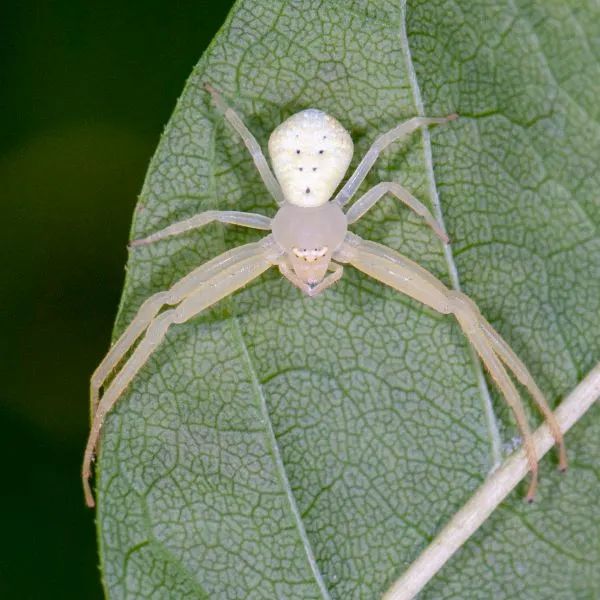
- Experience Level: Beginner
- Family: Thomisidae
- Scientific Name: Misumessus oblongus
- Other Names: Ridge-Faced Flower Spider, Foliage Flower Crab Spider
- Adult Size: 0.12 to 0.5 inches
- Lifespan: 1 Year
- Average Price Range: N/A
American green crab spiders have been sighted in several US states, including Illinois. Most of these sightings occur in May. These crab spiders are partial to marshes, meadows, garages, woodlands, grasslands, forests, and shrublands.
American green crab spiders are roaming hunters that often climb up vegetation to feed on arthropods. Since they don’t build webs, they rely on their speed, venomous fangs, and strong forelimbs when attacking and stinging prey.
The body and legs of American green crab spiders are pale green to silver white, with no markings or rings. Some individuals have pink or reddish patterns on their bodies. The legs of this spider protrude outward from the sides, allowing it to freely move in any direction.
The abdomen of the female green crab spider is usually creamy white, while that of males is brown. In most green crab spiders, the abdomen is shaped like a diamond or a kite. The carapace, abdomen, and legs of this species all bear spines.
They usually have their mating season in the summer. Males look for silk threads to locate females and place sperm packets on the surface. Females then search for sperm, collect it with leg-like projections called palps, and fertilize their eggs with the sperm.
Females put their fertilized eggs in silk cocoons near the web and cover them with plant leaves a few days later. They keep their eggs safe for the next 3 weeks and don’t eat anything during this period. After hatching, the females die of exhaustion.
The venom of this species is only dangerous to their prey and not humans.
28. Broad-faced Sac Spider

- Experience Level: Beginner
- Family: Trachelidae
- Scientific Name: Trachelas tranquillus
- Other Names: Bullheaded Sac Spider, Sac Spider
- Adult Size: Up to 0.63 inches
- Lifespan: 1 year
- Average Price Range: N/A
Broad-faced sac spiders are outdoor spiders. However, they may stray into houses in fall when temperatures drop. When they do, they usually don’t establish large reproducing populations indoors.
They have a solid dark brown or reddish cephalothorax that sometimes glints when exposed to a light source. The abdomen is usually tan and lacks distinct patterns, while the legs are brown, tan, or even reddish. The front pair is almost always much darker than the rest.
People often mistake broad-faced sac spiders for woodlouse hunters because they have similar colors. But you can differentiate broad-faced sac spiders by their long jaws and fangs, as well as their widely-spaced eyes.
Broad-faced sac spiders are nocturnal hunters, so they don’t make web traps for prey. However, they spin thin sac-like shelters to hide in during the day. They are named after these sacs.
Their bite is initially painful and can cause redness or inflammation, usually because of their huge fangs. If you’re allergic to spider venom, these symptoms may be more severe. But you’ll be all right because their venom is not medically significant.
29. Triangulate Cobweb Spider
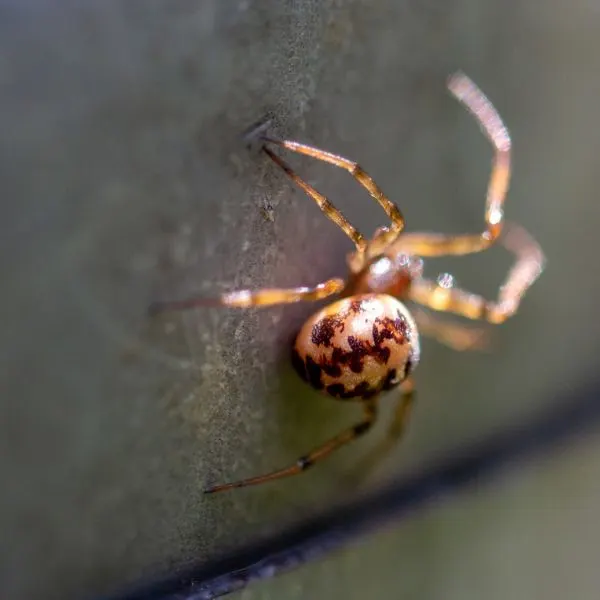
- Experience Level: Beginner
- Family: Theridiidae
- Scientific Name: Steatoda triangulosaC
- Other Names: Triangulate Bug Spider, Triangulate Combfoot
- Adult Size: 0.12 to 0.25 inches
- Lifespan: 1 to 3 years
- Average Price Range: N/A
This common house spider is often overlooked due to its tiny size. Its name is derived from the triangular patterns on the dorsal part of the abdomen. The triangular pattern is formed by a pair of white to yellow zigzag markings running down the abdomen.
It also has a large, bulbous abdomen. People sometimes mistake this species for the brown widow spider, but the triangulate cobweb spider does not have the hourglass marking characteristic of widow spiders.
Although this spider mainly feeds on insects smaller than itself, it can easily subdue prey many times its size. It’s not a hunter, so it relies on its messy but efficient webs to trap its victims before injecting them with venom.
It’s common to find triangulate cobweb spiders indoors. These arachnids often build their nests in wall corners, on windowsills, and on dark or irregularly cleaned parts of the house. They avoid interacting with people and often run when disturbed.
Although they are related to the infamous widow spiders, the venom of these arachnids is mild. It is harmless to humans, although it can cause mild allergic reactions like pain and swelling.
The venom of triangulate cobweb spiders is sometimes used in sprays for controlling pests like moths, flies, and mosquitoes.
30. Wetland Giant Wolf Spider
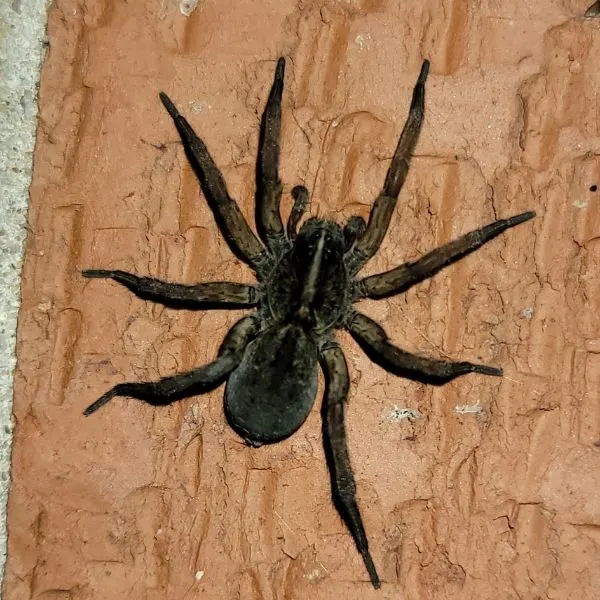
- Experience Level: Beginner
- Family: Lycosidae
- Scientific Name: Tigrosa helluo
- Other Names: Wolf Spider
- Adult Size: 0.39 to 0.94 inches
- Lifespan: 1 to 2 years
- Average Price Range: N/A
Wetland giant wolf spiders in Illinois are nocturnal hunters with good eyesight and keen senses. They stalk their victims before pouncing on them and delivering venomous bites. Once their prey is immobilized, the spiders begin liquefying their victim’s insides for consumption.
You can identify wetland giant wolf spiders by the black or gray arrow-shaped marking in the middle of their abdomens. The body of this species is mostly tan brown with large areas on its carapace and abdomen covered in black or gray hair.
Two of this spider’s 8 eyes are enlarged and its tan brown legs are mottled with black or gray spots. It’s often mistaken for nursery web spiders because of its color. However, the arrowhead marking on its abdomen helps differentiate them.
The wetland giant wolf spider is a solitary spider, so it hunts alone—except during mating seasons. It doesn’t build typical webs, but it spins silk cocoons to hold its eggs. Females carry these eggs attached to their spinnerets until they hatch.
The wetland giant wolf spider is not aggressive towards people, so it will not attack unless provoked. When it bites, its venom may trigger minor pain and swelling but isn’t medically significant.
31. Dimorphic Jumping Spider
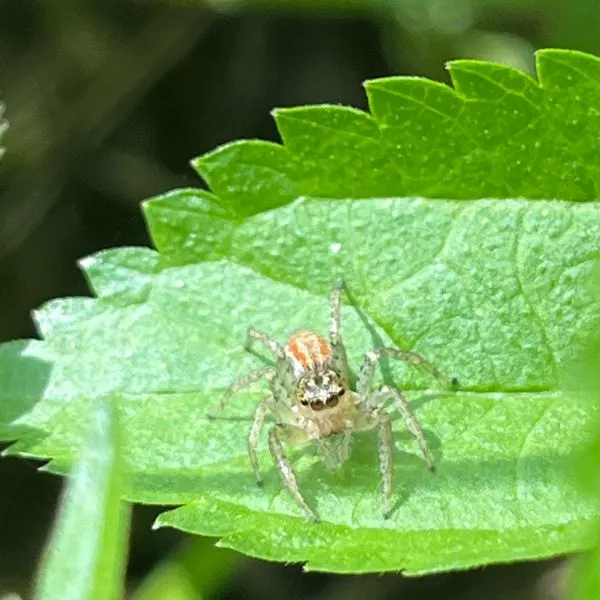
- Experience Level: Beginner
- Family: Salticidae
- Scientific Name: Maevia inclemens
- Other Names: Dimorphic Jumper
- Adult Size: 0.18 to 0.39 inches
- Lifespan: 1 year
- Average Price Range: N/A
Dimorphic jumping spiders in Illinois are often found along hiking trails, tree lines, and on plants and flowers like poison ivy. Like most jumping spiders, they are generalist predators that feed on a variety of small insects and other arthropods.
This fascinating species is the only known jumping spider with dimorphic males. Males occur in two morphs with distinct appearances and courtship behaviors, and you’ll usually find both in roughly equal numbers in dimorphic jumping spider populations.
The striped morph, also known as the gray morph, has yellow to orange pedipalps. Its body is gray with white stripes and subtle orange markings. Some people mistake it for the zebra jumping spider, but zebra spiders lack their distinctive orange pedipalps.
The black morph or tufted morph is black, and it has 3 black tufts on its head. However, its legs are white.
It’s still unknown what circumstances influence which morph a male will take. As a result, predicting which morph a juvenile dimorphic jumping spider will assume as an adult is challenging.
Female dimorphic jumping spiders have a white face, and two red or black lines run down the back of their abdomens. They have black bodies and white legs. Unlike males, females aren’t dimorphic.
Like all jumping spiders, dimorphic jumping spiders have excellent vision. The main eyes, in the front-and-center position, are large, while the remaining pairs along the sides of the head work as motion detectors. The eyes are used for hunting, spotting potential threats, and finding mates.
Dimorphic jumping spiders bite when distressed, but their venom is harmless.
32. Zebra Jumping Spider
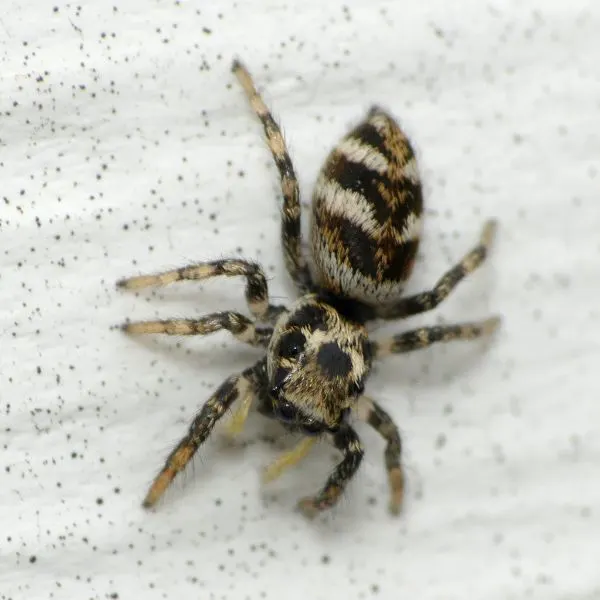
- Experience Level: Beginner
- Family: Salticidae
- Scientific Name: Salticus scenicus
- Other Names: Zebra Jumper, Zebra Spider
- Adult Size: 0.19 to 0.35 inches
- Lifespan: 1 year
- Average Price Range: N/A
Zebra jumping spiders have white and black stripes—much like the zebras, they are named after. These spiders have a black ground color, and the white stripes are simply regions of white hair. Some individuals have dark brown bodies instead of black.
Despite its size, the zebra spider is a great jumper. It has strong back legs and efficiently regulates the pressure in these legs to make impressive jumps. It also spins silk draglines to assist it with risky jumps.
Although zebra spiders don’t spin conventional webs, they spin silk cocoons to keep their eggs. Females protect these egg sacs for as long as possible before they hatch.
Instead of using web traps, these spiders hunt prey on the ground, relying on their speed and strong limbs. They pounce on unsuspecting prey and inject them with venom before consuming their victims.
Zebra jumping spiders have an interesting mating ritual. Males perform a seductive dance in which they move their abdomens up and down while waving their front limbs.
They are more likely to successfully woo females if they can shuffle flawlessly. The better the dance, the more willing females are to mate.
Zebra jumping spiders are safe to have around. They are unaggressive and rarely bite people except provoked. Even if one bites you, its venom is harmless. But you might have minor allergic reactions like itching or mild pain in the bite area.
33. Furrow Orbweaver
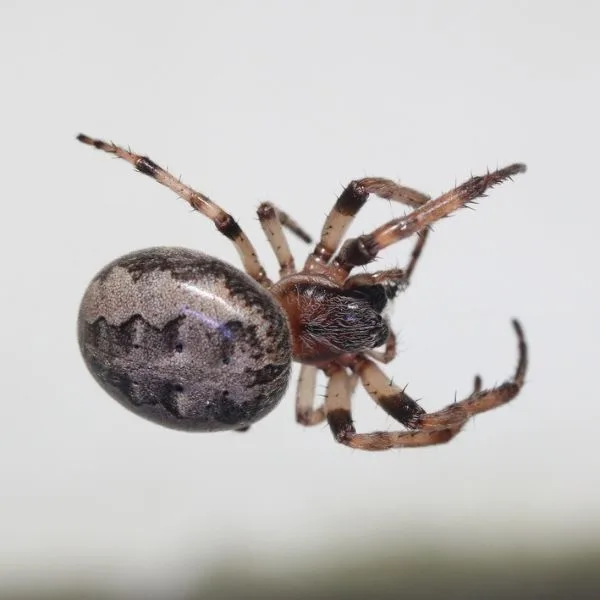
- Experience Level: Beginner
- Family: Araneidae
- Scientific Name: Larinioides cornutus
- Other Names: Furrow Spider, Foliate Spider, Furrow Orb Spider
- Adult Size: 0.4 to 0.5 inches
- Lifespan: 1 Year
- Average Price Range: N/A
You can find furrow orb-weavers in humid forests and coastal areas in Illinois. Although most furrow orb-weavers live outdoors, many of them migrate indoors during colder seasons. Indoor sightings are more common in fall as most don’t survive the cold when winter comes.
Furrow orb-weavers are named after the zigzag pattern on the back of their abdomens. This pattern looks like wavy ridges or furrows left behind after plowing a field. The furrow-like marking distinguishes furrow orb-weavers from similar-looking spiders in Illinois.
The cephalothorax of this species is nearly double the size of its oval abdomen. The carapace is also reddish-brown to gray, while the abdomen is smooth and glossy, unlike that of most orb-weavers.
Furrow orb-weavers look like bridge orb-weavers. However, the furrow orb-weaver has shorter legs, and its body isn’t as dark as that of the bridge orb-weaver. The first two pairs of legs are longer than the rest and are banded and spiky.
Furrow orb-weavers feed primarily on insects, but they eat other arthropods their webs trap. They locate victims on their wheel-shaped nests by following the vibrations these victims trigger on the webs when struggling.
Furrow orb-weavers are harmless. While their venom is not medically significant, it can cause mild allergic reactions like pain, redness, and/or itching. So be careful when handling these spiders.
34. Arabesque Orbweaver

- Experience Level: Beginner
- Family: Araneidae
- Scientific Name: Neoscona arabesca
- Other Names:
- Adult Size: 0.20 to 0.28 inches
- Lifespan: 1 Year
- Average Price Range: N/A
Arabesque orb-weavers are common in Illinois woodlands, forests, and gardens. These orb-weavers also live in man-made structures throughout the state. They earned their name from the beautiful whirling designs on their large abdomens.
You can easily identify these orb-weavers by the swirling pattern on their abdomens shortly after they shed their covering. But, sadly, the pattern becomes less visible as the spiders mature. This makes differentiating older arabesque orb-weavers from similar species more challenging.
These arachnids come in various colors, such as red, green, orange, brown, and gray. The legs of these spiders have alternating light and dark stripes and are covered in many tiny black spines.
Females weave vertical webs to trap flying insects, which they inject with venom before eating. They sleep in the middle of their webs at night, but they retreat from the webs during the day and hide inside curled and tied leaves.
Like other orb-weavers, arabesque orb-weavers are non-aggressive spiders. These spiders only bite when threatened, but their bite is harmless. If you’re allergic, you might experience symptoms like redness and itching. But these go away on their own.
35. False Widow
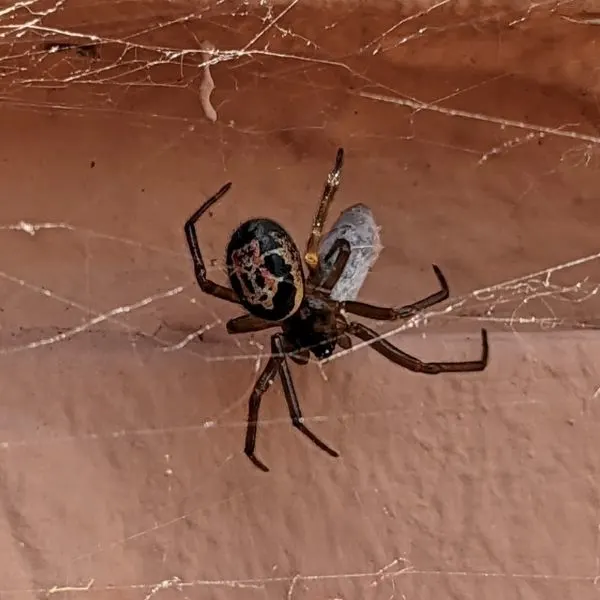
- Experience Level: Beginner
- Family: Theridiidae
- Scientific Name: Steatoda nobilis
- Other Names: False Black Widow, Dark Comb-Footed Spider, Cupboard Spider, Brown House Spider
- Adult Size: 0.25 to 0.4 inches
- Lifespan: 1 to 6 years
- Average Price Range: N/A
False widows belong to the same family as black widows and are frequently mistaken for their infamous cousins. Fortunately, these spiders are nowhere as venomous and are generally non-aggressive. They often retreat when threatened and only bite if they have no choice.
The venom false widows inject is harmless to humans. However, you might have mild swelling, fever, and pain comparable to a bee sting. These symptoms don’t require medical attention.
The best way to tell the difference between false widows and true widows is to examine their undersides. False widow spiders lack the reddish hourglass marking characteristic of true black widows. Furthermore, dark-colored false widows are more purplish or brownish than solid black.
Instead of an hourglass marking, the abdomens of false widows have bright patterns and are covered with short hair. Males have smaller, extended abdomens, while females have bulbous abdomens.
False widows spin webs to catch prey. Although these webs are messy and tangled, they are effective at trapping insects and other arthropods. These spiders then sting their victims before consuming them.
36. Flower Crab Spider
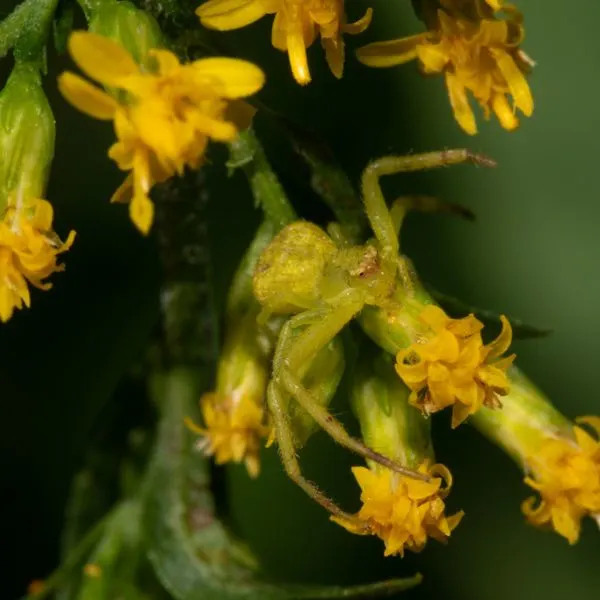
- Experience Level: Beginner
- Family: Thomisidae
- Scientific Name: FS
- Other Names: Goldenrod Crab Spider, Smooth Flower Crab Spider
- Adult Size: 0.125 to 0.75 inches
- Lifespan: 1 year
- Average Price Range: N/A
Flower crab spiders are ambush predators that can change their color to match their surroundings. They can only switch between white and yellow, but this color change often takes days or weeks to complete. As a result, most flower crab spiders stick to one flowerhead for a long time before moving on to new ones.
Besides their cryptic coloration, it helps that most of their arthropod prey lack well-developed eyes that can effectively distinguish between colors. As a result, flower crab spiders easily ambush victims even when staying on flowerheads that don’t perfectly match their bodies.
Flower crab spiders are generally white or yellow, depending on the color of the flowerhead they inhabit. Females have a broad reddish-orange band running down each side of their abdomens. Their first pair of legs has three spines as well.
Female flower crab spiders have yellowish legs and pale or yellowish carapaces. Both sides of their carapaces have black or dark brown stripes.
On the other hand, males have greenish-yellow carapaces and partially purple legs.
Flower crab spiders can inflict painful bites, but this rarely ever happens. These spiders are not aggressive, and their venom is not medically significant.
37. Hentz Orbweaver

- Experience Level: Beginner
- Family: Araneidae
- Scientific Name: Neoscona crucifera
- Other Names: Barn Spider, Spotted Orb-weaver
- Adult Size: Up to 0.75 inches
- Lifespan: 1 year
- Average Price Range: N/A
Hentz orb-weavers are one of the many spiders in Illinois. They are nocturnal arachnids with brown or rust bodies. You will find them in households, grassy fields, bushes, and damp forests.
The abdomen of this species is large and covered in thick whitish bristles. In addition, the abdomen of the Hentz orb-weaver has a spotted pattern that’s more visible in younger individuals. As the spider matures into an adult, the pattern becomes indistinct and makes it difficult to differentiate.
The brownish cephalothorax is much smaller than the abdomen and bears some light markings. The legs are often reddish-brown with alternating light and brown bands on some parts.
Hentz orb-weavers are harmless spiders. They don’t bite except held too tightly or brushed against. Even when they bite, their venom only triggers mild reactions that don’t need medical attention.
Like other orb-weaving spiders, the Hentz orb-weaver builds oval webs to trap prey and stay overnight. This arachnid builds its web on solid surfaces and eats it in the morning before hiding away. It rebuilds its web every evening.
This orb-weaver mainly feeds on insects and other smaller arthropods. However, females sometimes show cannibalistic behavior and consume their male partners after mating.
Like most spiders, spotted orb-weavers don’t do well in the cold. Most don’t survive winter.
38. Orchard Orbweaver
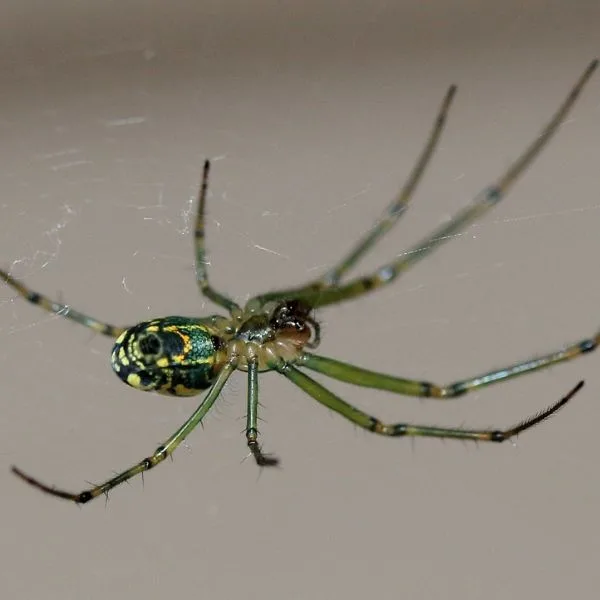
- Experience Level: Beginner
- Family: Tetragnathidae
- Scientific Name: Leucauge venusta
- Other Names: Long jawed Orb-weaver, Venusta Orchard spider, Orchard spider
- Adult Size: 0.12 to 0.25 inches
- Lifespan: 1 year
- Average Price Range: N/A
The orchard orb-weaver has a long jaw and a large abdomen covered in several beautiful colors. Although orchard orb-weavers are small, their abdominal patterns make them easy to spot when they inhabit open spaces. Sadly, they rarely stay out in the open for long.
As their name suggests, orchard orb-weavers typically inhabit orchards. You’ll also find them in other places with vegetation, such as shrublands, bushes, and gardens. They build horizontal webs that span a few feet and often hang upside-down from the center of these webs.
These spiders drop down from their webs and hide under thick plants or floor debris anytime they sense potential threats. Juveniles build nests close to the ground, but adults anchor their webs much higher.
The beauty of the long-jawed orb-weaver is proof that not all spiders are frightening or creepy-looking creatures. Besides this spider’s multi-colored abdomen, you’ll also notice dark brown or black stripes on its yellowish-green carapace.
Besides being pleasant to observe, orchard orb-weavers are safe to be around. These timid spiders rarely bite, and even when they do, their venom isn’t strong enough to cause harm. You might experience mild reactions if you’re allergic, but you don’t need treatment.
Orchard orb-weavers reserve their venom for arthropod prey, which they trap using their webs. Male orb-weavers defend themselves from cannibalistic females during mating using their fangs, so they aren’t killed as much as other orb-weaving spiders.
39. Metallic Crab Spider

- Experience Level: Beginner
- Family: Philodromidae
- Scientific Name: Philodromus marxi
- Other Names: Running Crab Spider
- Adult Size: 0.07 to 0.43 inches
- Lifespan: 1 year
- Average Price Range: N/A
The metallic crab spider is a long arachnid with long, skinny legs. It belongs to the running crab spider family, so it has incredible speed that helps it escape predators and catch highly elusive insects.
This skilled hunter doesn’t trap prey using webs. When it pounces on insect prey, it injects its victim with its venom and doesn’t let go until the insect stops moving. It then proceeds to consume its victim.
The name of this arachnid comes from the smooth metallic sheen of the male species. Males have smooth, brown, or rose gold bodies. Females, on the other hand, are gray with patches of bristly white hair. Females lack the sheen characteristic of males.
You’ll usually find metallic crab spiders on tall grasses and the branches and leaves of trees and garden plants. These spiders also spend time roaming on the ground in search of insects.
Although metallic crab spiders don’t spin webs to trap prey, they spin silk cocoons to house their eggs. Female metallic crab spiders are protective of their egg sacs and guard them for as long as they can.
40. Slender Crab Spider
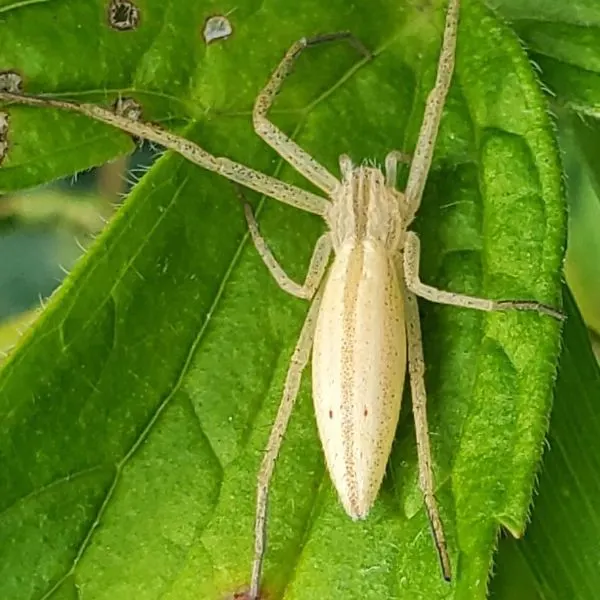
- Experience Level: Beginner
- Scientific Name: Tibellus spp.
- Other Names: Crab Spider
- Adult Size: 0.19 to 0.43 inches
- Lifespan: 1 year
- Average Price Range: N/A
Slender crab spiders have elongated bodies. The abdomen is long and lean, while the cephalothorax is about half its length and relatively wider. These arachnids come in several shades, but all have a long brown band running along the middle of the carapace and abdomen.
Their bodies have a lighter hue than the central stripe and are covered in short whitish or ivory-colored hairs. The hair isn’t obvious in many individuals. The legs are also brownish.
You’ll usually find these spiders among grasses and in other areas with ample vegetation. Their yellowish or brownish bodies provide them with excellent camouflage on plant stems and branches.
These spiders are ambush hunters that prey on various arthropods. Although they don’t spin webs to catch prey, they spin large cocoons to protect their eggs. Females guard these egg cases dutifully until the eggs hatch into spiderlings.
Slender crab spiders are venomous, as virtually all spiders are. But their venom isn’t medically significant and only triggers mild reactions. Besides, slender crab spiders generally only bite as a last resort when threatened.
Frequently Asked Questions
Still have unanswered questions about the spiders in Illinois? Read on to learn more about these fascinating creatures.
What do spiders in Illinois eat?
Spiders in Illinois eat insects like gnats, ants, moths, woodlice, beetles, and other small arthropods. Many spiders in Illinois eat other spiders. Cannibalistic behavior is common among some species, such as black widows, where females eat males after mating. Some spiders in Illinois also consume other animals like tiny fish, slugs, and tadpoles.
Where can I find spiders in Illinois?
You can find spiders in Illinois almost anywhere you look. These arachnids usually hide in humid places, under rocks and debris. But some prefer open, sunny spaces where they can display their webs and trap flying insects.
Different species have specific preferences about their habitat conditions, so it’s important you find out where your favorite spider typically hangs out.
If you don’t find the spiders in your home interesting enough, you can check nearby gardens and forests for spiders. If you’re patient in your quest, you’re bound to come across some interesting species.
Are there any poisonous spiders in Illinois?
Illinois is home to several types of venomous spiders. But this isn’t a problem as most species don’t inject venoms potent enough to harm you. You’ll usually only experience mild pain and redness or itching. Some bites are painless and don’t trigger any allergic reactions.
Black widows and brown recluses are the species you should be wary of in Illinois. They inflict painful bites that usually need medical attention to prevent complications. Black widows cause fever, nausea, breathing difficulties, and muscle paralysis in some individuals.
Brown recluses inject cytotoxic venoms that kill off surrounding tissue and can cause large ulcers that don’t heal well. These ulcers can become infected with bacteria or leave behind unpleasant scars.
Can a spider bite kill you?
Spider bites can kill, but most species don’t have venoms toxic enough to cause death. Black widows are the only spiders in Illinois capable of inflicting lethal bites.
The venom of these spiders typically causes fever, delirium, and difficulty breathing. In children, elderly people, or people with weak immune systems, black widow bites can result in death.
Are there jumping spiders in Illinois?
Yes. There are jumping spiders in Illinois. These amazing creatures come in different appearances and sizes, and Illinois is lucky to have quite a number of them.
Are there recluses in Illinois?
Yes. Illinois is home to the brown recluse, a particularly venomous spider. Brown recluses generally stay hidden and rarely wander out in the open, so sightings aren’t as common as other species.
Are there wolf spiders in Illinois?
Yes. There are several types of wolf spiders in Illinois. Although this family is pretty diverse, it can be difficult to categorize many of the wolf spiders in Illinois into the right species without expert help or thorough examination.
Can you keep pet spiders in Illinois?
You can keep spiders as pets in Illinois. Although spiders are generally more low maintenance than other popular pets, not all of them are easy to keep. Species that have low-risk venoms are the easiest to care for, especially if you’re allergic to spider venom.
If you plan to keep more venomous species as pets, ensure you keep them in enclosed spaces to prevent accidental contacts that could result in bites.
Wrapping up
There are many spiders in the world, and Illinois is home to a variety of them. As you have seen, the distinctive behaviors and appearances of these creatures make them nothing short of fascinating.
Contrary to popular belief, most spiders aren’t just harmful and creepy home invaders you need to get rid of. These arachnids are beneficial to the ecosystem and can be nice to have around. Except for the large webs some species spin, these arachnids are generally unobtrusive.
Although spiders may not be the choice pet for many people, there are benefits to having them around. Besides being ecosystem-friendly, these arachnids require much less care and attention than other common pets.
Spiders in other nearby states
